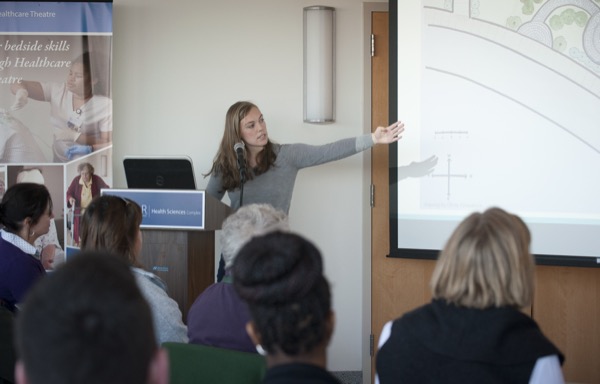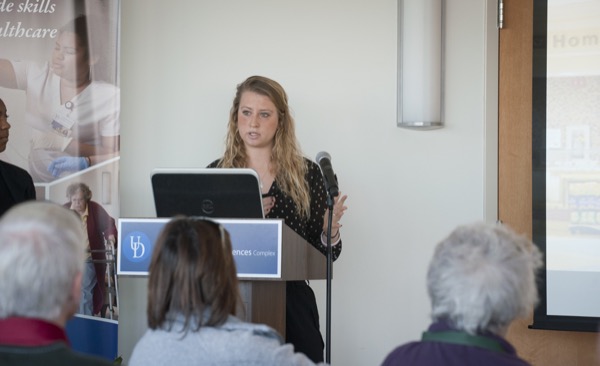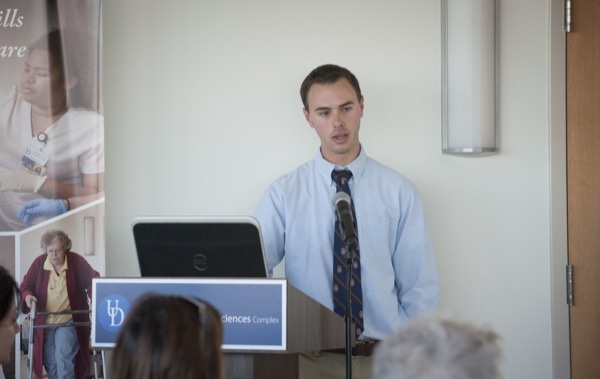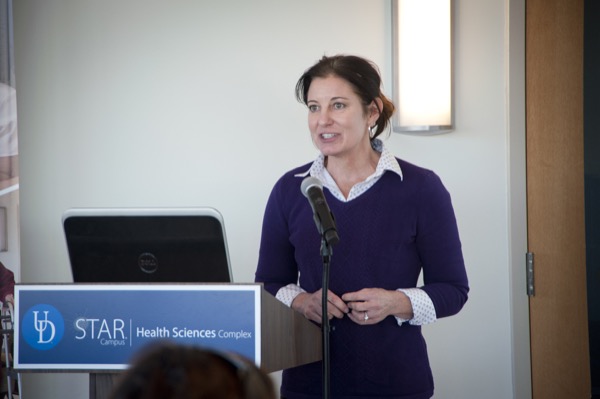Better living
Landscape design students accept challenge to create active outdoor spaces
3:07 p.m., Dec. 8, 2015--From therapeutic gardens to facilities promoting healthy foods, University of Delaware students in an interdisciplinary landscape design course accepted an “Activating Outdoor Space Challenge” this semester.
The challenge was designed by Jules Bruck, associate professor in the Department of Plant and Soil Sciences in the College of Agriculture and Natural Resources (CANR), and it asked students to create better spaces on the UD campus.
Campus Stories
From graduates, faculty
Doctoral hooding
The student teams presented their work Thursday, Dec. 3, in the Health Sciences Complex Atrium on the Science, Technology and Advanced Research (STAR) Campus.
Bruck said the focus of the fall semester course was “landscape architecture foundation concepts, like how to build community and how to design with an eye for nature, ecological design.”
The course also considered “how to craft space that the community would want to use in terms of spatially designing something that has great form, and productive use of land,” she said.
The students, who were drawn from five of UD’s seven colleges and represented 18 different majors, ranged from freshmen to graduate students. They worked on the project for a majority of the semester.
Bruck said this was especially interesting for the freshmen who, along with the rest of the class, had to make a presentation to a team of engineers from Fore Sites Associates in New Castle as part of their first design challenge to create floating wetlands that could enhance water quality.
“How would you like to be, in the first semester of your freshmen year, put into a class where three weeks into the semester you are presenting in front of engineers off campus? It’s really a unique opportunity for them,” said Bruck.
For their final project of the semester, the class was split up into eight groups with projects focused on topics such as how to provide healthier food options, how to create a space that can generate ongoing revenue, how to design an outdoor space demonstrating the variety of agriculture and natural resources taught in CANR, and how to create an outdoor space that demonstrates the variety of therapeutic and healing methods and resources taught and administered at the STAR Campus, among others.
The students were able to choose the project, as Bruck wanted them to “self-select teams in a way that they were able to work on a project that really interested them.”
Among the eight projects that were presented, the Healthy Eating Group proposed a Blue Hen Barn in a field near Worrilow Hall that would offer healthier eating choices and increase awareness of what CANR has to offer as far as fresh vegetables, wool and honey.
“For getting actual food into the Blue Hen Barn, we were thinking of partnering with Newark Natural Foods and the UD Dining staff, which is doing a great job in incorporating healthy foods into UD’s diet,” said Elizabeth Omenitsch, a senior in the College of Earth, Ocean, and Environment.
The second level of the Blue Hen Barn would have a kitchen where the students suggested CANR could have classes. “It would be a good way to use the food grown on South Campus in a natural cooking environment. We talked to the ag students and the HRIM (Department of Hotel, Restaurant and Institutional Management) majors who are cooking at Vita Nova, and this kitchen could be a cool change of scenery for them,” said Omenitsch.
She also added that the group came up with the idea of having Blue Hen Barn be equipped with a patio space outside where people could do yoga or have meditation classes.
Another group worked on a therapeutic garden. Using a Facebook survey, as well as an in-person survey in the STAR atrium aimed at UD students, faculty and staff, the group learned that most people thought that mental health therapy would be best served by a therapeutic garden.
People said that “beautiful scenery” and “open space” are key, and students found that “getting outside is a huge motivating factor for people to work harder and enjoy the therapy more, thus leading to better outcomes,” said Nick Limminia.
The group also spoke with UD professionals to get their thoughts on the project and, following those talks and incorporating other feedback received from the campus community, they decided on the theme of universal access for the garden.
“With this theme we had two major goals. The first was to use plants themselves as tools for therapy and the second was to use gardening as a tool for therapy. With both of these goals in mind, we’re hoping to target mental health therapy, physical therapy and speech therapy, as well as other types of therapies on the STAR Campus,” said Samantha Nestory, a master’s degree student in CANR.
The group proposed installing the garden to the left of the STAR Campus atrium and came up with a curvilinear and circular theme to emphasize the naturalness of the space, which would feature extra wide paths to be navigable for people with wheelchairs and other assisted mobility devices.
The most important part of the design was accessibility of planters for a garden bed, an herb garden and flower beds, which would be built to different heights in order to be available for use by everyone, Nestory said.
The garden would also have planters geared toward the senses with lowbush blueberry bushes and vegetables grown for taste, spicebush for smell, chenille plant and lambs ear for touch, and false blue indigo, with seed pods that rattle when they dry, for sound.
“You can really target a lot of senses with these plants,” said Nestory.
Article by Adam Thomas
Photos by Wenbo Fan














